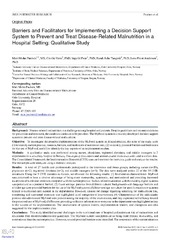| dc.description.abstract | Background: Disease-related malnutrition is a challenge among hospitalized patients. Despite guidelines and recommendations for prevention and treatment, the condition continues to be prevalent. The MyFood system is a recently developed decision support system to prevent and treat disease-related malnutrition. Objective: To investigate the possible implementation of the MyFood system in clinical practice, the aims of the study were (1) to identify current practice, routines, barriers, and facilitators of nutritional care; (2) to identify potential barriers and facilitators for the use of MyFood; and (3) to identify the key aspects of an implementation plan. Methods: A qualitative study was performed among nurses, physicians, registered dietitians, and middle managers in 2 departments in a university hospital in Norway. Focus group discussions and semistructured interviews were used to collect data. The Consolidated Framework for Implementation Research (CFIR) was used to create the interview guide and analyze the results. The transcripts were analyzed using a thematic analysis. Results: A total of 27 health care professionals participated in the interviews and focus groups, including nurses (n=20), physicians (n=2), registered dietitians (n=2), and middle managers (n=3). The data were analyzed within 22 of the 39 CFIR constructs. Using the 5 CFIR domains as themes, we obtained the following results: (1) Intervention characteristics: MyFood was perceived to have a relative advantage of being more trustworthy, systematic, and motivational and providing increased awareness of nutritional treatment compared with the current practice. Its lack of communication with the existing digital systems was perceived as a potential barrier; (2) Outer settings: patients from different cultural backgrounds with language barriers and of older age were potential barriers for the use of the MyFood system; (3) Inner settings: no culture for specific routines or systems related to nutritional care existed in the departments. However, tension for change regarding screening for malnutrition risk, monitoring and nutritional treatment was highlighted in all categories of interviewees; (4) Characteristics of the individuals: positive attitudes toward MyFood were present among the majority of the interviewees, and they expressed self-efficacy toward the perceived use of MyFood; (5) Process: providing sufficient information to everyone in the department was highlighted as key to the success of the implementation. The involvement of opinion leaders, implementation leaders, and champions was also suggested for the implementation plan. Conclusions: This study identified several challenges in the nutritional care of hospitalized patients at risk of malnutrition and deviations from recommendations and guidelines. The MyFood system was perceived as being more precise, trustworthy, and motivational than the current practice. However, several potential barriers were identified. The assessment of the current situation and the identification of perceived barriers and facilitators will be used in planning an implementation and effect study, including the creation of an implementation plan. | en_US |

